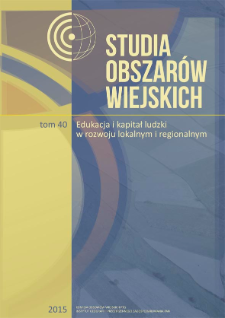- Wyszukaj w całym Repozytorium
- Piśmiennictwo i mapy
- Archeologia
- Baza Młynów
- Nauki przyrodnicze
Wyszukiwanie zaawansowane
Wyszukiwanie zaawansowane
Wyszukiwanie zaawansowane
Wyszukiwanie zaawansowane
Wyszukiwanie zaawansowane

Obiekt
Tytuł: Językowy obraz wieśniaka we współczesnej polszczyźnie = Linguistic image of a villager in the contemporary Polish language
Inny tytuł:
Studia Obszarów Wiejskich = Rural Studies, t. 40
Wydawca:
Miejsce wydania:
Opis:
Typ obiektu:
Abstrakt:
Celem artykułu jest przedstawienie językowego obrazu leksemu wieśniak we współczesnym języku polskim. Badanie przeprowadzono w oparciu o definicje zawarte w ogólnych i specjalistycznych słownikach języka polskiego oraz na podstawie ankiet. Pozwoliło to opisać stereotyp wieśniaka w świadomości Polaków, który zasadza się na połączeniu znaczenia gramatycznego i metaforycznego. Już nawet w opracowaniach leksykograficznych doszło do niepokojącego braku wyodrębnienia potocznego rozumienia tego słowa, tj. wieśniak – człowiek niekulturalny, niewychowany. W większości opracowań leksykograficznych komponent ze znaczenia gramatycznego człowiek ze wsi został wbudowany w definicje znaczeniowe metaforycznego rozumienia badanego leksemu. Również badania ankietowe potwierdzają tę tezę. Dla respondentów wieśniak to mieszkaniec wsi, który ponadto odznacza się następującymi cechami: brakiem obycia, nieznajomością kultury, posługiwaniem się gwarą, prostactwem, brakiem inteligencji.
Bibliografia:
1. Bańko M. (red.), 2000, Inny słownik języka polskiego, t.2, PWN, Warszawa.
2. Bańko M., 2010, Wielki słownik wyrazów bliskoznacznych, PWN, Warszawa.
3. Doroszewski D. (red.), 1968, Słownik języka polskiego, t. 9, PWN, Warszawa.
4. Dunaj B. (red.), 2001, Słownik współczesnego języka polskiego, t. 2, Przegląd Reader's Digest, Warszawa.
5. Falińska B., 1981, O języku inteligencji mazowieckiej pochodzenia chłopskiego, [w:] H. Zgółkowa (red.), Współczesna polszczyzna. Wybór zagadnień, PWN, Warszawa.
6. Kowalski P., 2004, Popkultura i humaniści. Daleki od kompletności remanent spraw, poglądów i mistyfikacji, Wydawnictwo Uniwersytetu Jagiellońskiego, Kraków.
7. Kurzowa Z. (red.), 2002, Słownik synonimów polskich, PWN, Warszawa.
8. Müldner-Nieckowski P., 2004, Wielki słownik frazeologiczny języka polskiego, Świat Książki, Warszawa.
9. Pawlus M., Gajewska B., 2009, Słownik synonimów i antonimów, PWN, Warszawa.
10. Skorupka S. (red.), 1971, Słownik wyrazów bliskoznacznych, PWN, Warszawa.
11. Sobol E. (red.), 2008, Słownik frazeologiczny PWN z Bralczykiem, PWN, Warszawa.
12. Sobol E., Drabik L. (red.), 2007, Słownik języka polskiego PWN, PWN, Warszawa.
13. Szymczak M. (red.), 1981, Słownik języka polskiego PWN, t. 3, PWN, Warszawa.
14. Zgółkowa H. (red.), 1998, Praktyczny słownik języka polskiego, Kurpisz, Poznań.
15. Zgółkowa H. (red.), 2004, Nowy słownik gwary uczniowskiej, PWN, Warszawa.
Czasopismo/Seria/cykl:
Tom:
Strona pocz.:
Strona końc.:
Szczegółowy typ zasobu:
Format:
Rozmiar pliku 2 MB ; application/pdf
Identyfikator zasobu:
oai:rcin.org.pl:58065 ; 1642-4689 ; 10.7163/SOW.40.13
Źródło:
CBGiOŚ. IGiPZ PAN, sygn. Cz.4488 ; CBGiOŚ. IGiPZ PAN, sygn. Cz.4489 ; kliknij tutaj, żeby przejść
Język:
Język streszczenia:
Prawa:
Licencja Creative Commons Uznanie autorstwa 3.0 Polska
Zasady wykorzystania:
Zasób chroniony prawem autorskim. [CC BY 3.0 PL] Korzystanie dozwolone zgodnie z licencją Creative Commons Uznanie autorstwa 3.0 Polska, której pełne postanowienia dostępne są pod adresem: ; -
Digitalizacja:
Instytut Geografii i Przestrzennego Zagospodarowania Polskiej Akademii Nauk
Lokalizacja oryginału:
Dofinansowane ze środków:
Programme Innovative Economy, 2010-2014, Priority Axis 2. R&D infrastructure ; European Union. European Regional Development Fund
Dostęp:
Kolekcje, do których przypisany jest obiekt:
- Repozytorium Cyfrowe Instytutów Naukowych > Kolekcje Partnerów > Instytut Geografii i Przestrzennego Zagospodarowania PAN > Publikacje pracowników i Wydawnictw
- Repozytorium Cyfrowe Instytutów Naukowych > Kolekcje Partnerów > Instytut Geografii i Przestrzennego Zagospodarowania PAN > Biblioteka Instytutu > Serie/Czasopisma/Cykle
- Repozytorium Cyfrowe Instytutów Naukowych > Piśmiennictwo > Książki/Rozdziały
Data ostatniej modyfikacji:
2 paź 2020
Data dodania obiektu:
1 mar 2016
Liczba pobrań / odtworzeń:
5070
Wszystkie dostępne wersje tego obiektu:
https://rcin.org.pl./publication/78069
Wyświetl opis w formacie RDF:
Wyświetl opis w formacie RDFa:
Wyświetl opis w formacie OAI-PMH:
Obiekty Podobne
Grotek, Edyta
Kochan, Anna

 INSTYTUT ARCHEOLOGII I ETNOLOGII POLSKIEJ AKADEMII NAUK
INSTYTUT ARCHEOLOGII I ETNOLOGII POLSKIEJ AKADEMII NAUK
 INSTYTUT BADAŃ LITERACKICH POLSKIEJ AKADEMII NAUK
INSTYTUT BADAŃ LITERACKICH POLSKIEJ AKADEMII NAUK
 INSTYTUT BADAWCZY LEŚNICTWA
INSTYTUT BADAWCZY LEŚNICTWA
 INSTYTUT BIOLOGII DOŚWIADCZALNEJ IM. MARCELEGO NENCKIEGO POLSKIEJ AKADEMII NAUK
INSTYTUT BIOLOGII DOŚWIADCZALNEJ IM. MARCELEGO NENCKIEGO POLSKIEJ AKADEMII NAUK
 INSTYTUT BIOLOGII SSAKÓW POLSKIEJ AKADEMII NAUK
INSTYTUT BIOLOGII SSAKÓW POLSKIEJ AKADEMII NAUK
 INSTYTUT CHEMII FIZYCZNEJ PAN
INSTYTUT CHEMII FIZYCZNEJ PAN
 INSTYTUT CHEMII ORGANICZNEJ PAN
INSTYTUT CHEMII ORGANICZNEJ PAN
 INSTYTUT FILOZOFII I SOCJOLOGII PAN
INSTYTUT FILOZOFII I SOCJOLOGII PAN
 INSTYTUT GEOGRAFII I PRZESTRZENNEGO ZAGOSPODAROWANIA PAN
INSTYTUT GEOGRAFII I PRZESTRZENNEGO ZAGOSPODAROWANIA PAN
 INSTYTUT HISTORII im. TADEUSZA MANTEUFFLA POLSKIEJ AKADEMII NAUK
INSTYTUT HISTORII im. TADEUSZA MANTEUFFLA POLSKIEJ AKADEMII NAUK
 INSTYTUT JĘZYKA POLSKIEGO POLSKIEJ AKADEMII NAUK
INSTYTUT JĘZYKA POLSKIEGO POLSKIEJ AKADEMII NAUK
 INSTYTUT MATEMATYCZNY PAN
INSTYTUT MATEMATYCZNY PAN
 INSTYTUT MEDYCYNY DOŚWIADCZALNEJ I KLINICZNEJ IM.MIROSŁAWA MOSSAKOWSKIEGO POLSKIEJ AKADEMII NAUK
INSTYTUT MEDYCYNY DOŚWIADCZALNEJ I KLINICZNEJ IM.MIROSŁAWA MOSSAKOWSKIEGO POLSKIEJ AKADEMII NAUK
 INSTYTUT PODSTAWOWYCH PROBLEMÓW TECHNIKI PAN
INSTYTUT PODSTAWOWYCH PROBLEMÓW TECHNIKI PAN
 INSTYTUT SLAWISTYKI PAN
INSTYTUT SLAWISTYKI PAN
 SIEĆ BADAWCZA ŁUKASIEWICZ - INSTYTUT TECHNOLOGII MATERIAŁÓW ELEKTRONICZNYCH
SIEĆ BADAWCZA ŁUKASIEWICZ - INSTYTUT TECHNOLOGII MATERIAŁÓW ELEKTRONICZNYCH
 MUZEUM I INSTYTUT ZOOLOGII POLSKIEJ AKADEMII NAUK
MUZEUM I INSTYTUT ZOOLOGII POLSKIEJ AKADEMII NAUK
 INSTYTUT BADAŃ SYSTEMOWYCH PAN
INSTYTUT BADAŃ SYSTEMOWYCH PAN
 INSTYTUT BOTANIKI IM. WŁADYSŁAWA SZAFERA POLSKIEJ AKADEMII NAUK
INSTYTUT BOTANIKI IM. WŁADYSŁAWA SZAFERA POLSKIEJ AKADEMII NAUK




































